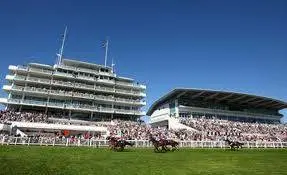Epsom Downs Racecourse
Over 150 views on venues4hire.org

Epsom Downs Racecourse - Epsom Downs Racecourse
To make a booking or enquire about hiring this venue please use the contact details below - Please mention Venues for Hire
01372 726 311
Bookings Administrator
Use contact form below
Epsom Downs Racecourse description
Commercial Venue
Medium (1-150)
The strange origin of Epsom’s rise to fame came in 1618, when herdsman, Henry Wicker discovered a water hole northwest of the turnpike road, between Epsom and Ashtead. Although the water, thought to be undrinkable, was examined by local physicians, it was a further 12 years before the highly purgative qualities of the water were discovered - one gallon of water containing 480 grains of calcareous nitre.
What followed was a product that became known as Epsom Salts, which at its height, sold at five shillings an ounce in 1640. Samuel Pepys wrote in his diary of 1667, “We got to Epsom by 8 a-clock to the Well, where much company; and there we light and I drank the water.”
Later he visited the King’s Head, the nearest inn to the downs, “where my Lord Buckhurst and Nelly (Nell Gwynne, the King’s mistress), is lodged at the next house, and keeps a merry house.”
Epsom’s earliest race-days were in the 1640s
In mid-May 1648, during the throes of the Civil War, the Earl of Clarendon in his History of the Rebellion relates, “a meeting of the royalists was held on Banstead Downs, under the pretence of a horse race, and six hundred horses were collected and marched to Reigate.” This suggests that for such an under-cover rendezvous to take place, racing at Epsom must have been a regular and well attended occasion.
Under the Commonwealth (1649-60), horseracing was banned, but upon its demise, the first recorded race meeting in the country took place at Epsom on 7 March 1661, in the presence of Charles II.
Throughout the fluctuating fortunes in the town, race meetings on the downs had become a regular feature in May and October from 1730, with prizes of cups and plates provided by the local nobility.
The Foundation of the Derby and Oaks
At the Epsom May Meeting in 1778, Lord Derby invited a party of friends to his house, The Oaks, where it was proposed, that a single race over one and a half miles for three-year-old fillies would add some spice to the meeting the following year. The race, named after Lord Derby’s house, was first run on 14 May 1779, and was appropriately, won by Lord Derby’s Bridget, the well backed favourite. The race was considered a great success and as a result, another new race for both colts and fillies was planned for the following year.
Legend has it that the 12th Earl of Derby and Sir Charles Bunbury (the leading figure in the Jockey Club, who was staying at The Oaks) spun a coin as to whether the race should be called the Derby or, the Bunbury Stakes. The first running of the Derby Stakes was over a mile and although Lord Derby won the toss of the coin, it was Sir Charles Bunbury who owned the first winner – Diomed.
The Prince’s Stand
The Stand dates in its present form from 1879, when the original Regency stand, built c1784, was altered and enlarged. Used by the Prince of Wales, later King George IV, it housed the royal party celebrations when the Prince won the Derby with Sir Thomas in 1788. Up until 1829, it was the only permanent building on the Downs, although by 1831, when the Princess Victoria visited Epsom, it was struggling to keep the royal entourage comfortably ensconced.
In 1940, soon after the outbreak of war, racing at Epsom was abandoned for the duration and given over to the military; the Prince’s Stand was then commandeered as the Officers Mess. In 1979, as part of the celebrations for Derby 200, the Prince’s Stand was extensively refurbished and, it’s continued use links together more than 22 decades of history.
The Great Metropolitan and City and Suburban Handicaps
Now run at the one-day, Spring Meeting, were the very first two races to be sponsored. With the Epsom management struggling to put up enough prizemoney, Samuel Beeton, a publican in Milk Street, opened a subscription for the first handicap and then, persuaded his fellow publicans in Fleet Street to follow suit.
At that time, many London pubs served both as betting shops and ale-houses. “The Great Met,” as it became known, was first run in 1846, and run over 2m 2f, until 1985, when changed to 1m 4f.
The City and Suburban, run over 1m 2f, followed in 1851, with subscriptions raised from pubs in the City of London, stretching out to the suburbs – hence its name. Incidentally, the first occasion the photo-finish camera was used in Great Britain, was at Epsom, on 22 April 1947, to determine the placings for The Great Metropolitan Handicap.
Modern day Epsom
Epsom racecourse has moved from the 20th to the 21st century with a succession of notable improvements. The Queens Stand was opened by Her Majesty in 1992 (Derby won by Dr Devious), with the use of a new paddock behind the stands. In 1993 (Derby winner Commander-in-Chief), the first large screen was erected in the home straight; full colour racecards appeared in 1995 and most recently, the Duchess Stand was opened by The Duchess of Cornwall in 2009 (Oaks winner Sariska). A year later, the 120 bedroom hotel, Holiday Inn Express, opened on the site of the old paddock, bringing the convenience of an overnight stay.
Meanwhile, after racing, an enterprising management have given us a series of top quality pop concerts, including, Debbie Harry and Blondie, who entertained a crowd of 13,000 on a warm July evening.
Finally, let’s not forget the racecourse – the main attraction – lovingly cared for by expert ground staff.
What followed was a product that became known as Epsom Salts, which at its height, sold at five shillings an ounce in 1640. Samuel Pepys wrote in his diary of 1667, “We got to Epsom by 8 a-clock to the Well, where much company; and there we light and I drank the water.”
Later he visited the King’s Head, the nearest inn to the downs, “where my Lord Buckhurst and Nelly (Nell Gwynne, the King’s mistress), is lodged at the next house, and keeps a merry house.”
Epsom’s earliest race-days were in the 1640s
In mid-May 1648, during the throes of the Civil War, the Earl of Clarendon in his History of the Rebellion relates, “a meeting of the royalists was held on Banstead Downs, under the pretence of a horse race, and six hundred horses were collected and marched to Reigate.” This suggests that for such an under-cover rendezvous to take place, racing at Epsom must have been a regular and well attended occasion.
Under the Commonwealth (1649-60), horseracing was banned, but upon its demise, the first recorded race meeting in the country took place at Epsom on 7 March 1661, in the presence of Charles II.
Throughout the fluctuating fortunes in the town, race meetings on the downs had become a regular feature in May and October from 1730, with prizes of cups and plates provided by the local nobility.
The Foundation of the Derby and Oaks
At the Epsom May Meeting in 1778, Lord Derby invited a party of friends to his house, The Oaks, where it was proposed, that a single race over one and a half miles for three-year-old fillies would add some spice to the meeting the following year. The race, named after Lord Derby’s house, was first run on 14 May 1779, and was appropriately, won by Lord Derby’s Bridget, the well backed favourite. The race was considered a great success and as a result, another new race for both colts and fillies was planned for the following year.
Legend has it that the 12th Earl of Derby and Sir Charles Bunbury (the leading figure in the Jockey Club, who was staying at The Oaks) spun a coin as to whether the race should be called the Derby or, the Bunbury Stakes. The first running of the Derby Stakes was over a mile and although Lord Derby won the toss of the coin, it was Sir Charles Bunbury who owned the first winner – Diomed.
The Prince’s Stand
The Stand dates in its present form from 1879, when the original Regency stand, built c1784, was altered and enlarged. Used by the Prince of Wales, later King George IV, it housed the royal party celebrations when the Prince won the Derby with Sir Thomas in 1788. Up until 1829, it was the only permanent building on the Downs, although by 1831, when the Princess Victoria visited Epsom, it was struggling to keep the royal entourage comfortably ensconced.
In 1940, soon after the outbreak of war, racing at Epsom was abandoned for the duration and given over to the military; the Prince’s Stand was then commandeered as the Officers Mess. In 1979, as part of the celebrations for Derby 200, the Prince’s Stand was extensively refurbished and, it’s continued use links together more than 22 decades of history.
The Great Metropolitan and City and Suburban Handicaps
Now run at the one-day, Spring Meeting, were the very first two races to be sponsored. With the Epsom management struggling to put up enough prizemoney, Samuel Beeton, a publican in Milk Street, opened a subscription for the first handicap and then, persuaded his fellow publicans in Fleet Street to follow suit.
At that time, many London pubs served both as betting shops and ale-houses. “The Great Met,” as it became known, was first run in 1846, and run over 2m 2f, until 1985, when changed to 1m 4f.
The City and Suburban, run over 1m 2f, followed in 1851, with subscriptions raised from pubs in the City of London, stretching out to the suburbs – hence its name. Incidentally, the first occasion the photo-finish camera was used in Great Britain, was at Epsom, on 22 April 1947, to determine the placings for The Great Metropolitan Handicap.
Modern day Epsom
Epsom racecourse has moved from the 20th to the 21st century with a succession of notable improvements. The Queens Stand was opened by Her Majesty in 1992 (Derby won by Dr Devious), with the use of a new paddock behind the stands. In 1993 (Derby winner Commander-in-Chief), the first large screen was erected in the home straight; full colour racecards appeared in 1995 and most recently, the Duchess Stand was opened by The Duchess of Cornwall in 2009 (Oaks winner Sariska). A year later, the 120 bedroom hotel, Holiday Inn Express, opened on the site of the old paddock, bringing the convenience of an overnight stay.
Meanwhile, after racing, an enterprising management have given us a series of top quality pop concerts, including, Debbie Harry and Blondie, who entertained a crowd of 13,000 on a warm July evening.
Finally, let’s not forget the racecourse – the main attraction – lovingly cared for by expert ground staff.
Venue suitability
This venue is suitable for the following uses:
Venue facilities
Other venue facilities
We don't currently hold any detailed information about the rooms at this Venue.
If this is your Venue or Hall please use the Adopt link on the right to add more detailed information about this Venue.
If you wish to hire this Venue or Hall please use the contact details on the overview tab.
Please encourage every Venue to take a few minutes to 'Adopt' their listing and add unique content and photos.
